Last Chance to Catch NYC's Holiday Notalgia Train
We met the voices of the NYC subway on our nostalgia ride this weekend!


2020 marks the 75th Anniversary of the founding of the United Nations. The United Nations came into being on October 24, 1945 when the United Nations Charter was ratified by the first fifty member nations. To mark the 75th Anniversary, the United Nations has launched UN75 — the largest, most inclusive conversation on the role of global cooperation in building a better future for all. Rather than having a traditional celebration, UN75 is giving the citizens of the world an opportunity to shape UN’s priorities, by inviting everyone, everywhere to have their say, and to share their ideas for a better future. The core of the initiative is a short, one-minute survey focusing on the key priorities for international cooperation. Results from the survey will be presented to world leaders and governments this September. In addition, the United Nations is holding UN75 dialogues, where organizations can hold virtual events to discuss key global issues.
Untapped New York is proud to be an official collaborator with the United Nations on their UN75 efforts. Earlier this month, we hosted two virtual tours with Visit UN going behind the scenes to learn about the history and architecture of the UN. To further highlight the United Nations and its unique architectural legacy here in New York City, we’re revealing a few of our favorite secrets of the United Nations!
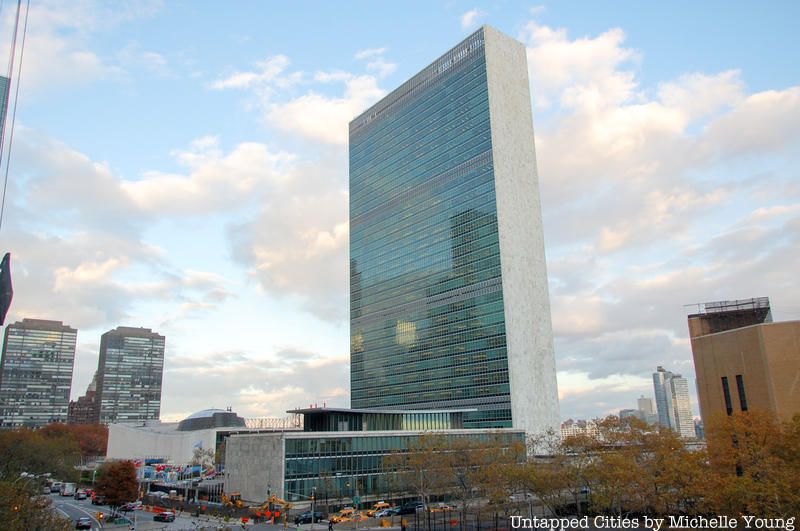
The United Nations headquarters is not technically under the jurisdiction of New York City, State or the United States. It’s on “Special Status Diplomatic Territory,” something akin to an independent international territory. It’s administered by the United Nations and has its own police force, fire department, and issues its own stamps. It also has its own radio broadcast studio, and television studio, as well as printing facilities.
Though most of the laws of the city, state and nation do apply here, one thing that does not is sales tax. This means the food and gifts you might buy on a visit to the UN will be tax free. In addition, sales of cigarettes and tobacco products were banned inside the UN in 2008, and smoking was banned in 2009.
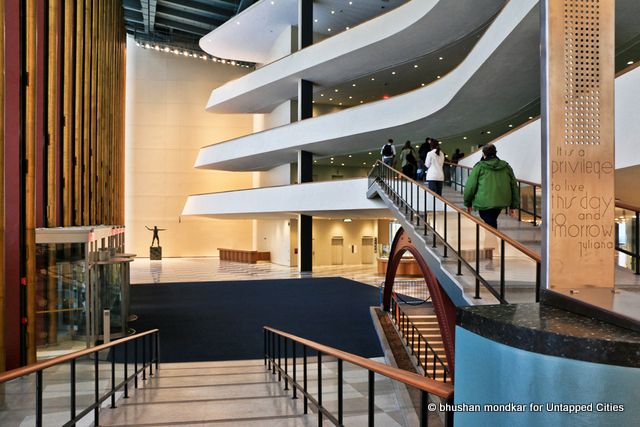
Here’s a secret most people don’t know: the United Nations has a massive subterranean complex that is only accessible to delegates and staff. It goes down two basement levels below what most people refer to as “the basement,” which is actually only the First Basement. On these levels there are offices, a gym for staff, maintenance and storage facilities. There is also a parking lot for UN vehicles and diplomatic cars. In other tunnel news, there is also a seventy-foot wide vehicular tunnel that was built under 1st Avenue from 42nd to 48th Street as part of the construction for the United Nations. The tunnel cost $2.28 million at that time and a familiar name was involved: Robert Moses, who was listed as the City Construction Coordinator.
Another fun fact: The United Nations headquarters is cooled using East River water, one of the few buildings left in New York City that does so. The vertical brass-colored tubes on the interior of the entrance facade to the General Assembly building are decorative but are also pipes that carry the cooling system for the building. According to Jonathan Mishal of Visit UN, units are located in the river that are cooled down by the water and send cool air back to the United Nations buildings. Due to potential environmental concerns, this practice is not permitted in New York City but in the recent renovation of the United Nations, the organization asked permission from the city of New York to continue this practice. If not, they would have had to add heating and cooling units on the roof of the building which would alter the design of the building.
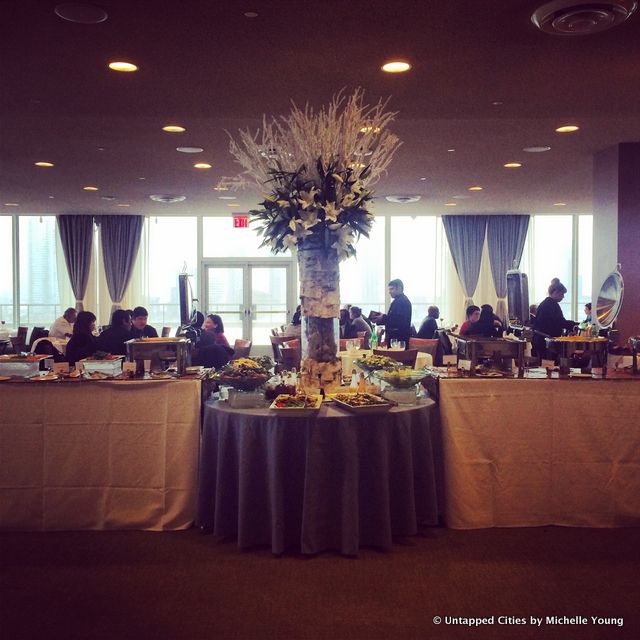
In 2014, following the renovation of the United Nations complex, the Delegates Dining Room quietly reopened in the General Assembly building. Relevant to us non-delegates is that the restaurant is actually open to the public, allowing us ordinary folks to brush past and sit amidst ambassadors, dignitaries and delegates. Though the mod-style architecture has mostly been replaced over the years, the view is just as stunning as ever.
The famous buffet is no longer offered, but there’s a prix-fix menu now. Advance reservation is necessary and airport style security clearance when you arrive. UN staff and Mission get a discount.
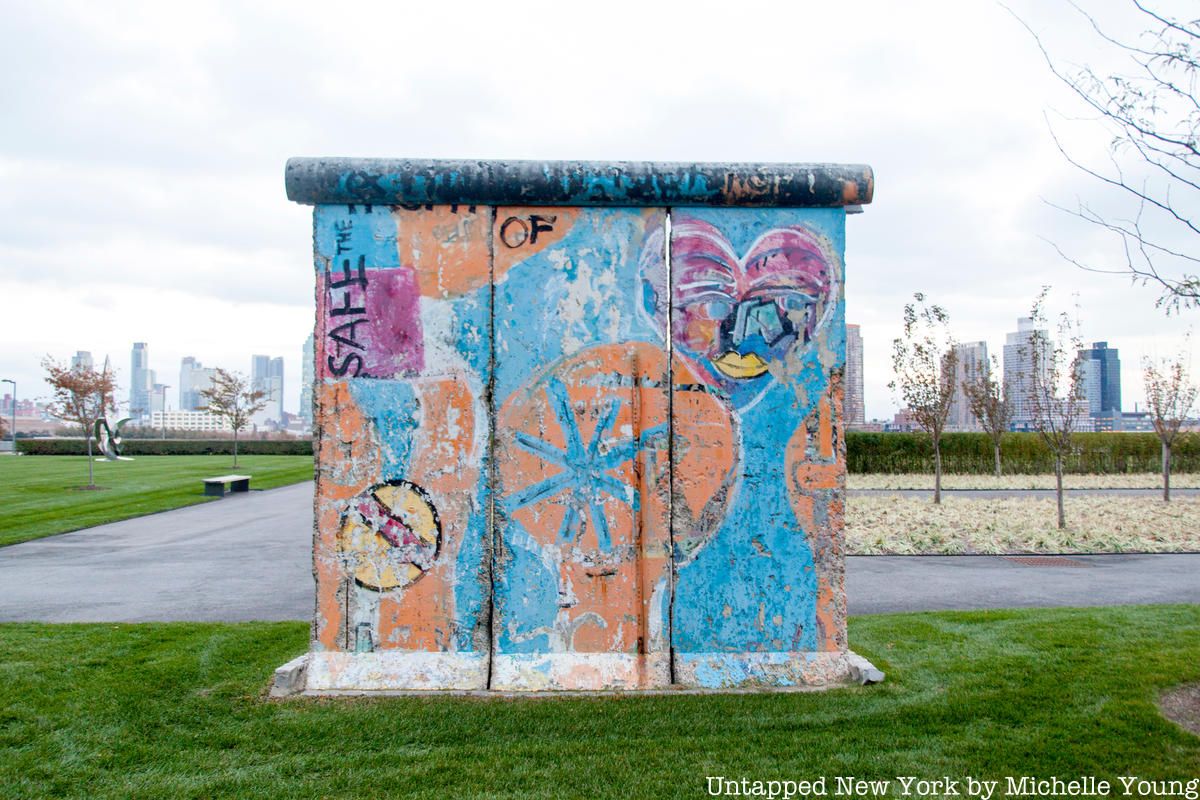
New York City is home to five sections of the Berlin Wall, the 12-foot high concrete barrier that stood between East and West Germany for 28 years. A Berlin Wall piece, which used be at Potsdamer Platz, stands in the United Nations Sculpture Garden, which contains gifts from many member countries of the UN. This three-slab section was gifted from Germany in 2002, presented by then-President of the German Bundestag, Wolfgang Thierse to then-UN Secretary General Kofi Annan. At the ceremony, Annan said, “The Berlin Wall was an offence to the human spirit. It not only marked the division of Germany and Europe, but also expressed, in a uniquely horrible way, the propensity of human beings to erect walls and borders, and then glare across them, hearts filled with hate, minds full of fear and distrust, all the while numb to the notion that there might be a better way.”
The Berlin Wall section is painted on both sides with the slab standing as it would have in Berlin, with the east side facing east and the west side facing west. The side facing the East River is entitled “Trophy of Civil Rights” and depicts two people reaching over the top of the wall to embrace each other. It is believed that this painting was made between 1989 and 1990, following the reunification. The other side of the wall, facing 1st Avenue, is a graffiti work made German artist Kani Alavi, who has painted other sections along the wall’s East Side Gallery. He is one of the leaders of the initiative to retain the remnant section of the wall in Berlin as an open-air gallery.
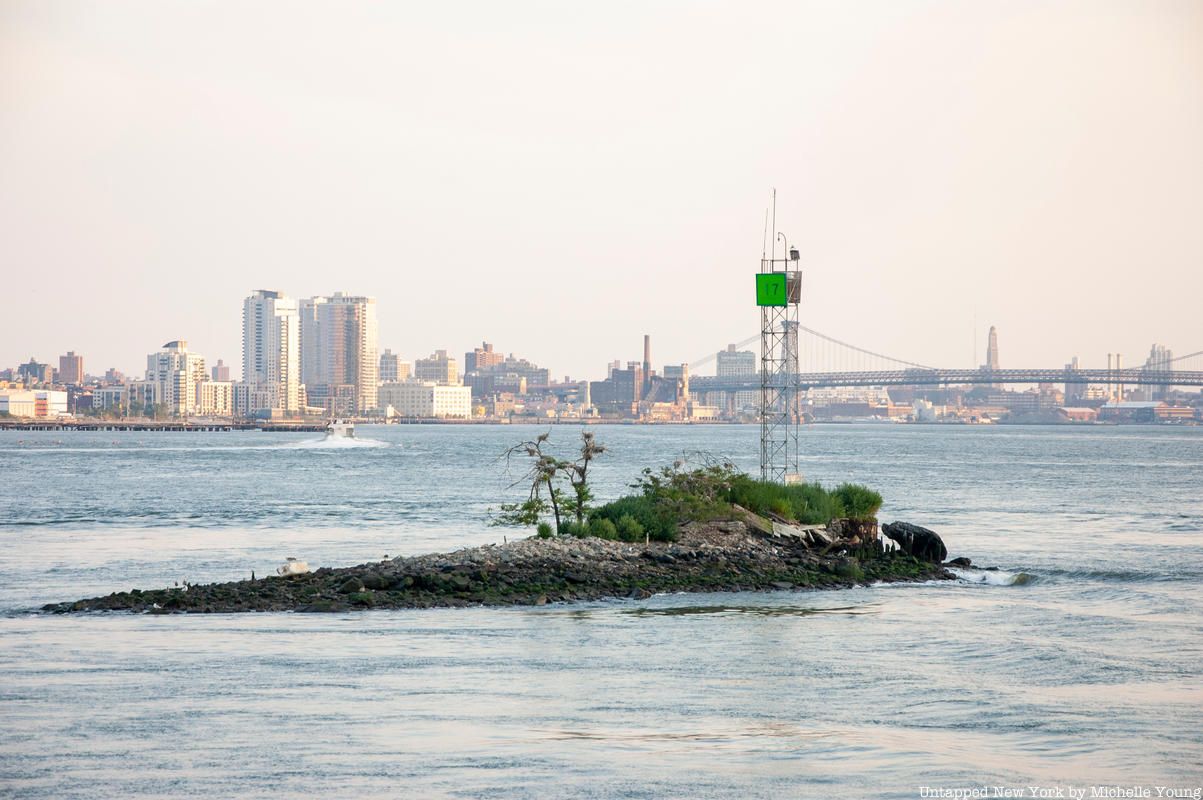
Situated halfway between the United Nations complex and Long Island City is a tiny 1/2 acre island that appeared in the East River in the 1890s. U Thant Island, as it is known, is nicknamed in tribute to former United Nations Secretary General from Burma. In the 1970s, a group of employees from the United Nations who were followers of the guru Sri Chinmoy and called themselves the Peace Meditation at the United Nations and named it for Chinmoy’s friend U Thant.
The use of U Thant Island was a formal takeover, as the group leased the island from the State of New York and dedicated the island on September 16, 1977 to U Thant, who had died three years before. The group was allowed on U Thant Island once or twice a year to maintain the greenery they planted. There was even an award ceremony for the U Thant Peace Award that took place there. But increased security ended visits by the mid 1990s. The group left behind a 30-foot tall steel “Oneness Arch” which has a capsule buried below containing personal items and writings from U Thant. In 2004, the island was back in the news when the artist Duke Riley sailed to U Thant Island in protest of increased security in New York City for the Republican National Convention, and proclaimed it a sovereign nation.
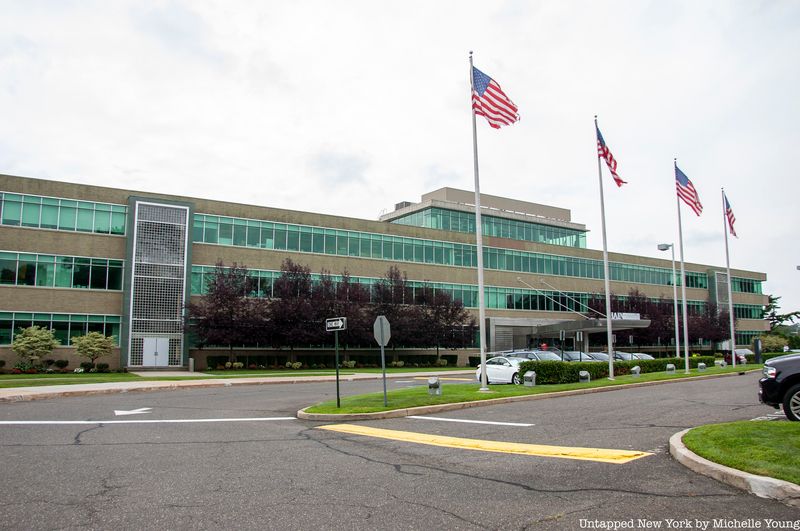 Former United Nations headquarters on Long Island at Lake Success
Former United Nations headquarters on Long Island at Lake Success
The United Nations had been many years in the making, with the first mention of a “United Nations” occurring in a January 1, 1942 speech by President Franklin D. Roosevelt. But even before, many countries around the world were meeting to ensure peace in the future, given the ravages of World War II. The St. James Palace Agreement of 1941, The Atlantic Charter of 1941, the Declaration of the United Nations in 1942, the Moscow and Tehran Conferences in 1943, and the Dumbarton Oaks and Yalta Conferences of 1944-1945 constitute the steps taken during and after World War II that led to the creation of the United Nations. In June 1945 in San Francisco, fifty nations came together at the United Nations Conference on International Organization to draw up the UN Charter, which was ratified in October that year. The United Nations headquarters in Manhattan was built between 1948 and 1952, but the UN General Assembly met in locations all over New York City and even Long Island, and around the world, prior to the complex of its permanent headquarters. These included the Hudson Hotel, Rockefeller Center, Hunter College’s Bronx Campus (now Lehman College), the New York City Building from the 1939 World’s Fair (now the Queens Museum), and the Sperry Gyroscope Corporation headquarters on Long Island. You can see each of these former locations here.
The location for the UN was also not a shoe-in. Originally on the site, developer William Zeckendorf, Sr. hoped to build a place called “X City,” a “Dream City” to rival Rockefeller Center. Zeckendorf liked to dream big but was unable to pay off the short term loans on this land parcel, so he sold the 17 acres to the Rockefellers in 1946 for a $2.5 million profit. The Rockefellers purchased the property with the intention of donating it for the United Nations headquarters. The $8.5 million purchase price is equivalent to $83 million today.
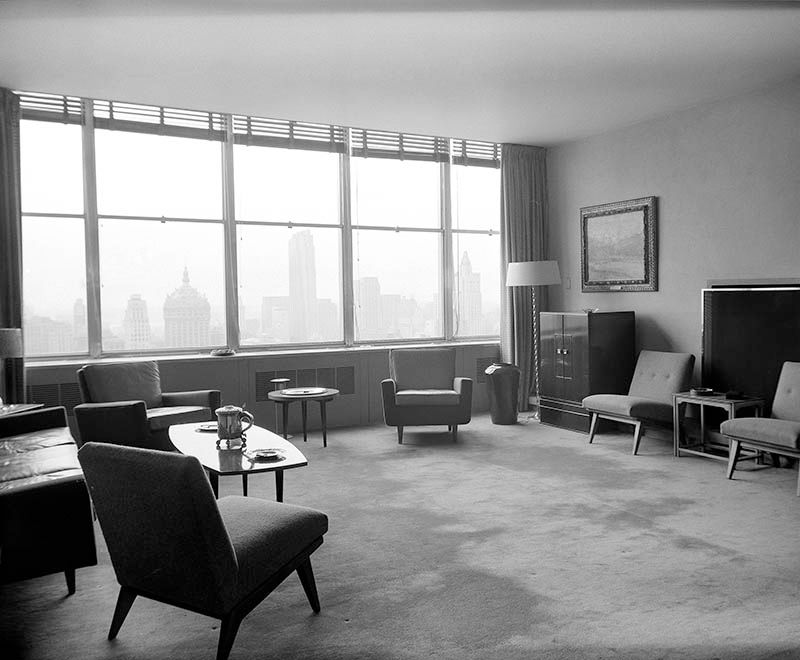
Partial view of the living-room, in the private apartment provided for the Secretary-General of the United nations on the 38th Floor of the Secretariat Building. From January 1, 1953. UN Photo/MB
The Secretariat Building is an all-glass curtain wall building, 39 stories tall, hosting about 5,000 international civil servants working inside on a daily basis in normal operation. It is designed in the International Style, prioritizing transparency and neutrality, with an aesthetic connection to the surrounding environment. The UN Secretary-General, António Guterres and his direct staff work on the the 38th floor, the very top of the Secretariat building has an incredible view of New York. Those who work in the United Nations use the shorthand “38th floor” to refer to the topmost leadership of the UN.
In addition to offices and conference rooms on the 38th floor, there was also once a private apartment provided to the UN Secretary-General! Historic photos from the 1950s show a nice-sized living room with large windows that span the width of the room, a modest kitchen and bathroom, and a single bed in the bedroom. It was used by UN Secretary-General Dag Hammarskjöld, the second Secretary-General, who died on a plane crash en route to a peacekeeping mission to the Congo, and by U Thant.
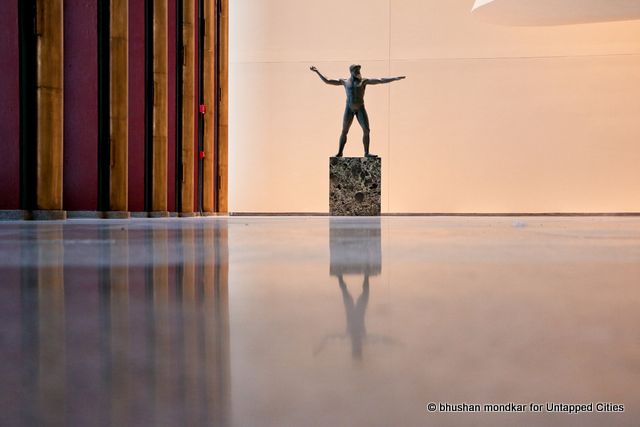
The United Nations complex is not an official museum, but its art collection makes it worth that designation. Gifts from the member countries that are in the collection includes stained glass by Marc Chagall, murals by Fernand Léger Jose Vela Zanetti, sculptures and much more. The most expensive gift comes from Saudi Arabia — a Kiswa, a golden threaded cover from the holy Kaaba in Mecca, made of 15 kilograms of gold and 630 kilograms of silk and showing the verses of the Quran. Jonathan Mishal of Visit UN says it’s so expensive, no American insurance company will insure it.
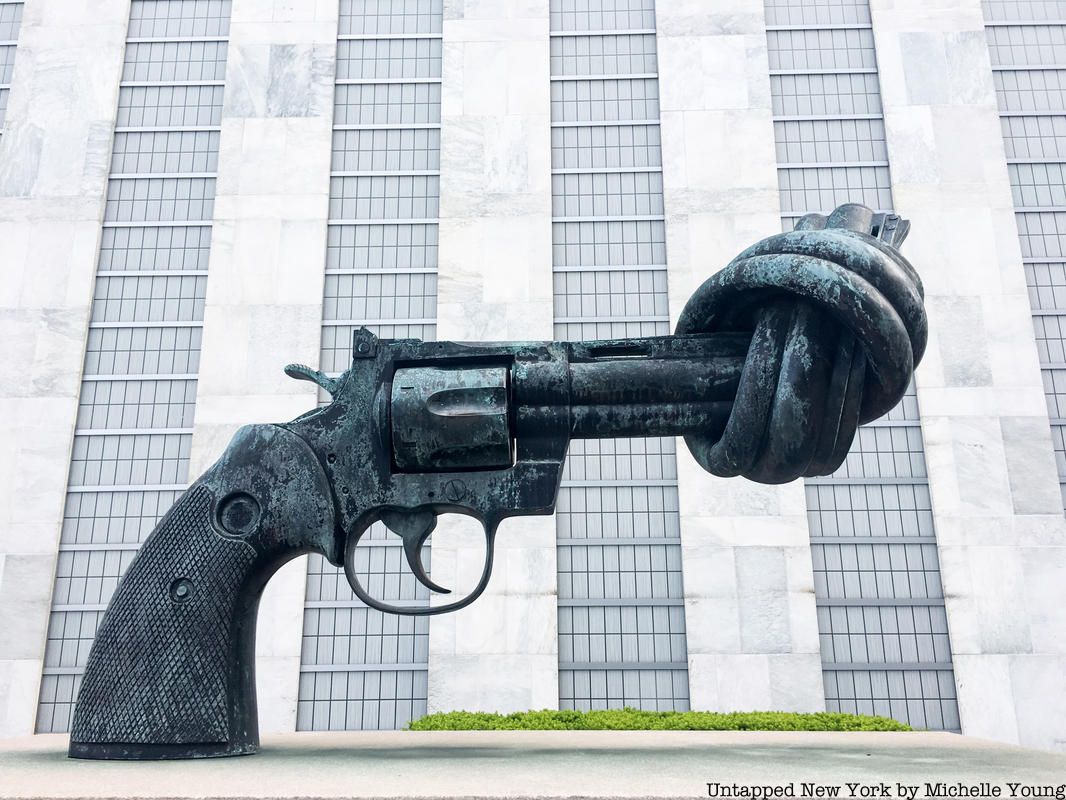
Outside, some notable pieces of sculpture besides the Berlin Wall piece, includes a lesser-known Eleanor Roosevelt Memorial, the Non-Violence “Knotted Gun” sculpture by Swedish artist Carl Fredrik Reuterswärd, the Sphere within a Sphere by Arnaldo Pomodoro, and a memorable sculpture from Russia entitled “Good Defeats Evil” by Georgian sculptor Zurab Tsereteli, a native depicting St. George slaying a dragon. The “dragon” is made from pieces of decommissioned Soviet SS-20 and US Pershing nuclear missiles that were destroyed under the terms of the Intermediate-Range Nuclear Forces Treaty of 1987.
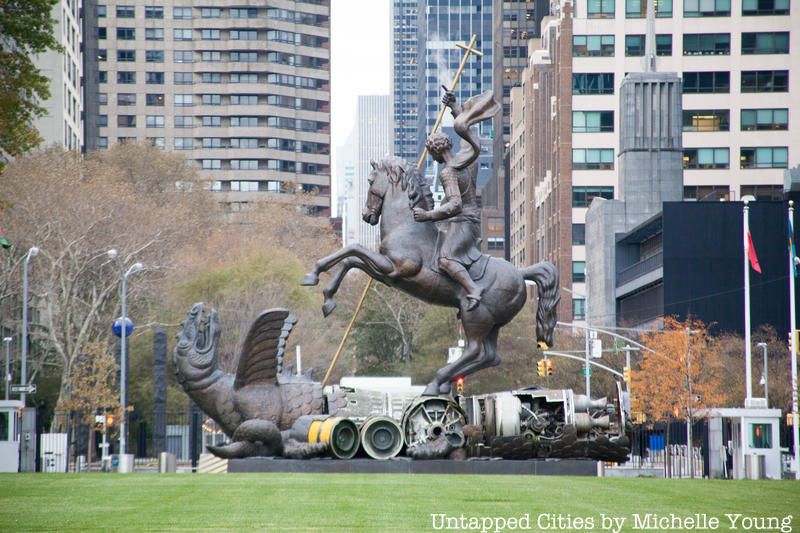
Good Defeats Evil

Inside the United Nations Sculpture Garden are three beekeeping boxes donated by Slovenia, painted in the United Nations blue. One is painted with Slovenian folk art. The bees, which are from swarms of Apis mellifiera linguistica (Italian honeybees) rescued from Queens, Brooklyn, and Connecticut, lay around 2,000 eggs per day. Here at the United Nations, they help pollinate the gorgeous Rose Garden and produce over 250 pounds of honey a year.
Former President of the General Assembly, Peter Thomson, who welcomed the initial three beehives said the intention was to expand the colony to 200,000 bees. The bees are cared for by Bees Without Borders.
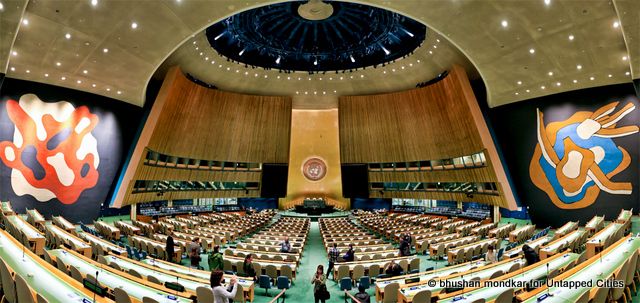
United Nations General Assembly
The United Nations’ $2.1 billion renovation from 2008 to 2014 was a massive undertaking that returned the architecture and aesthetics of the headquarters to their original beauty. United Nations employees refer to as the CMP, Capital Master Plan. The restoration also made the complex more energy efficient. In fact, it consumes about half the amount of energy it did prior to renovation. Some fun facts: As part of the renovation, enough asbestos was removed from the complex to fill three football fields fifteen feet high. A “gooey substance” of cigarette and cigar smoke residue was removed from the General Assembly hall, the largest room in the United National headquarters.
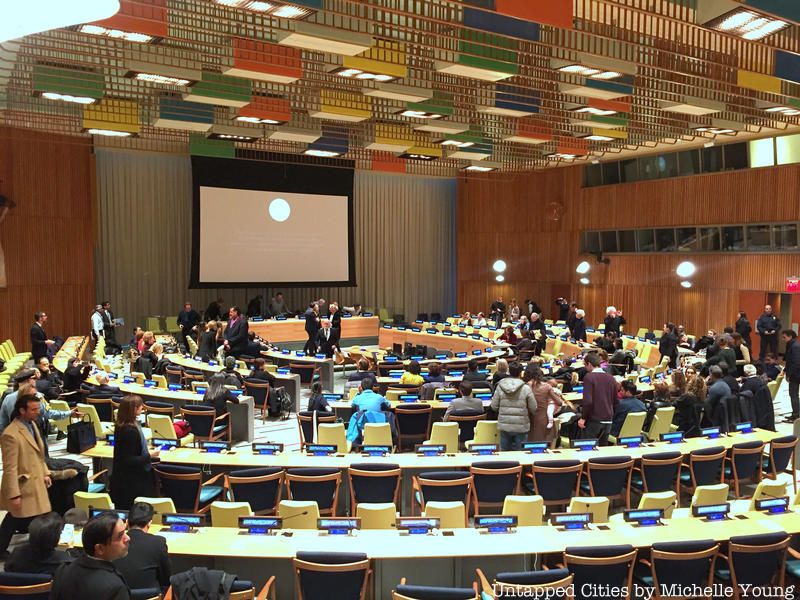
During the renovation, every vintage chair was restored and reupholstered, and the carpets replaced in their original colors. The Trusteeship Council, above, designed by Danish architect Finn Juhl, has a fun Mondrian-like vibe with echoing color motifs on the carpet and ceiling. The Trusteeship Council was built from seven kinds of wood from Denmark, intended to invoke the feel of a Danish forest, Visit UN guide Jonathan Mishal tells us. In 2011, The Queen Margrethe II and Prince Henrik of Denmark personally came to oversee the renovation of the chambers. The Queen made her mark by suggesting that a ledge be added to the tables so that papers would not fall off — now known as “the queen’s lip.” The Trusteeship Council oversaw the administration of Trust Territories placed under the Trusteeship System, promoted the advancement of the inhabitants of Trust Territories and their progressive development towards self-government or independence. The Council suspended operations with the independence of the last such Trust territory: Palau, in 1994 and currently only meets “as and where occasion may require”.
Places like the Delegates Lounge, below, retained its original feel but with a playful update.
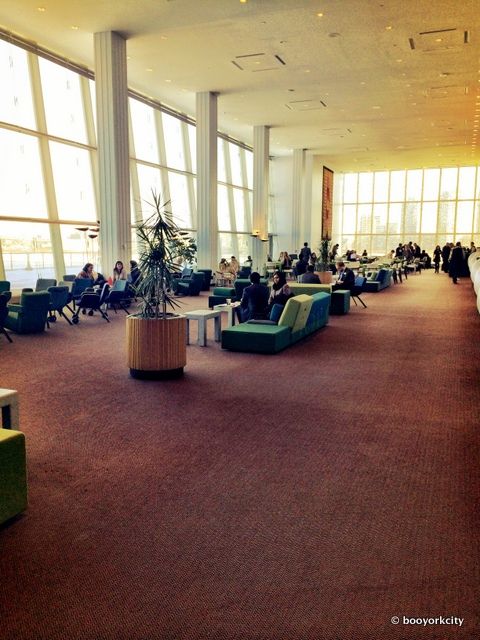
Inside the chamber of the Security Council, whose role is to maintain international peace and security, curtains have blocked natural sunlight in the room since 1964 after a bazooka was fired from across the East River during Che Guevara’s speech. Due to poor aim, the shell of the bazooka did not make it all the way and fell into the East River, but it was determined that it would have penetrated the glass of the building if shot properly. In the recent renovation, shatter-resistant glass was installed and on April 3, 2019, Germany opened the curtains for the first time since 1964 during a debate revealing a curtain wall of glass and views long concealed.

The mural by by Per Krohg with a phoenix rising in the Security Council chamber has symbolism relating to the agony of modern war, a world being rebuked after WWII, and peaceful life after WWII
Norwegian architect Arnstein Arneberg designed the interior decor of the United Nations Security Council, which was a gift from Norway. The tapestry, in blue with gold motifs showing anchors representing faith, hearts representing charity, and wheat representing hope, was designed by Norwegian textile artist Else Poulsson and based on a blue wool damask tapestry. It was in place from the opening of the UN in 1952 to the Security Council Chamber renovation in 2013, when a textile wallpaper recreation was installed.
On October 8th, 2015 HRH Crown Princess Mette-Marit of Norway donated an original piece of the tapestry to the Cooper Hewitt-Smithsonian Design Museum’s permanent collection in New York. In a ceremony, Mette-Marit stated, “When we think back on the early aspirations of the UN and how the headquarters in New York has influenced the world – these first inscriptions of peace into the very fabric of the walls of the Security Council Chamber are very moving.”
Finally, there are places inside United Nations headquarters that are paid for by countries and then named informally after them such as the Indonesian Lounge and the Vienna Cafe. A few years ago, Qatar donated a lounge (formally called the East Lounge, but referred to as the Qatar Lounge) to the UN building that cantilevers over the FDR Drive, overlooking the East River and Four Freedoms Park. It is heavily reinforced (construction wise) for safety, making it terror proof since it sits above a public highway. It’s intended as a space to host important diplomatic talks and also as a place to relax and rest for delegate members.
There are many more secrets of the United Nations than what we showcased here! While the United Nations headquarters is closed due to COVID-19, you can take virtual tours through Visit UN. Please also participate in the UN’s 75th Anniversary by filling out a short, one-minute survey focusing on the key priorities for international cooperation. Results from the survey will be presented to world leaders and governments this September. Stay tuned for our own Untapped New York event with UN75!
Subscribe to our newsletter